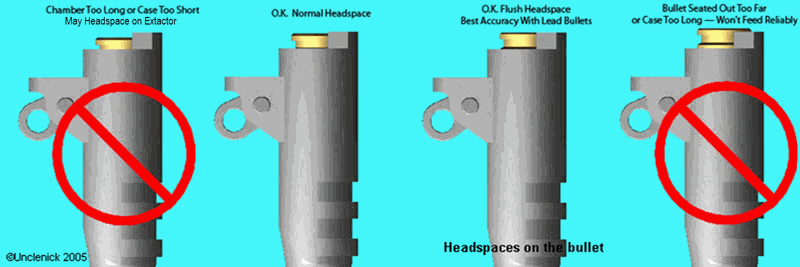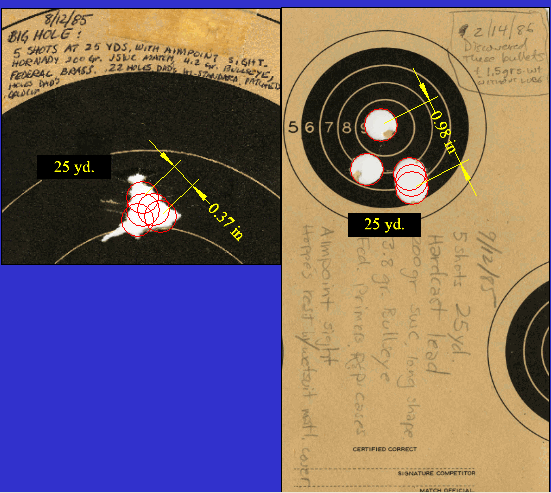Billglass said:
Is there an overall increase in pressure or pressure spike that would tell me to reduce the starting load (4.4 grains WST)?
The dynamics of the 45 Auto are different than in a high power rifle. The case doesn't stick to the chamber wall, instead backing up under pressure, so this stalls pressure rise in the way gas bypass does in a rifle whose case shoulder is locked in place when the bullet starts to move. Typical cast bullets for the .45 Auto are only about 1/3 as hard as jacketed bullets, so they just don't cause as much starting resistance into the rifling lands. Finally, lead bullets just don't get held as hard by the case as jacketed ones do, so we are really hoping to increase the start pressure a little closer to that of jacketed bullets for improved barrel time consistency.
I have a custom Encore barrel in .45 Auto with a strain gauge for my Pressure Trace on it. If folks are curious, remind me when the weather is better and I'll see if I can't work in some comparisons on several methods of loading lead in the .45 Auto. I could also compare them to standard equivalent loads of jacketed bullets, too. In the meanwhile, I can only say I've certainly never seen a pressure sign loading lead to touch the throat with lead.
I'll mention that I do not normally load jacketed bullets to touch the throat simply because it's unnecessary. I don't see an accuracy improvement doing this with jacketed bullets.
Reddog81,
The exact COL isn't as strict as it would be with jacketed bullets. My illustration shows the back of the case flush with the barrel extension (aka, hood) on the back of a 1911 barrel, but I've had them stick out by 0.010" or so and still feed properly. The lead is so soft it's no challenge for the recoil spring in my guns to start them into the lands.
Ozzie and Buck,
The answer to your question will depend on your chamber. If, as Jim Watson suggested, you can genuinely and repeatably headspace on the case mouth, then you may see less difference that I got when I first discovered this trick (I think quite a number of folk have discovered it independently) back about 1984, I was shooting a 185 grain soft swaged LSWC made by Star over 3.8 grains of Bullseye in my Goldcup for indoor matches (50 foot reduced targets). At that distance, off bags, the original load would shoot about 1 3/8 inch groups of ten at that range. That's dandy for a defensive pistol, but the 10 ring of a 50 foot reduced Conventional Pistol target is 0.9 inches, and so that was not good enough to clean targets. You need groups no bigger than 1.351" C-T-C and perfectly centered to clean that target with no worse than a scratch 10. When I tried that same load seated out to headspace on the bullet, the groups shrank 40% to under 7/8" C-T-C at 50 feet, and I had a gun that could shoot "possibles".
Why would it make so much difference? The comes down to what Jim Watson said about headspacing on the case mouth. If you can do that, you should shoot just as well or close to it. The problem back in the 80's was that .45 Auto pistols were mostly 1911's and, as one of the board's gunsmith members estimated, out of the box about 70% of 1911's he saw were actually headspacing on the extractor hook. In other words, the chamber was so long that the extractor hook was what was actually holding the cartridge still for the firing pin strike. The case mouth wasn't reaching the end of the chamber before this happened. Moreover, because .45 Auto cases don't stick to the chamber, they back up and get swelled shorter and fatter by pressure in the slightly tapered chamber, so they shrink with each load cycle. I've measured my target load cases losing about half a thousandth of an inch each time around. With light loads, by the time a bulk purchase of cases have all split or been lost in the grass, they are well below SAAMI minimum case length and would be headspacing on the extractor hook in about any gun chambered for the .45 Auto anyway. So, even if you don't have the extractor hook headspacing initially, you will later if you are frugal with your brass.
So, what's wrong with headspacing on the extractor hook? For jacketed bullets, nothing except extra extractor fatigue, that I can find. But jacketed bullets in the cartridge are strong enough that they can center themselves well in the barrel as they start to leave the case, and not be distorted by the chore. Lead bullets don't seem to center. If the extractor hook has pivoted the cartridge against the extractor hook side of the chamber with a lead bullet, it seems to swage into the bore at that small angle, shave some lead of against the chamber edge and unbalance and open groups up. As evidence of this, I offer that once you start headspacing lead bullets on the barrel throat, you will notice clean the gun how much less leading there is. Indeed, I've run over 3,000 rounds of lubricated lead 200 grain SWC's over Bullseye without cleaning and the barrel has only a few traces of lead near the throat. In fact, the gun stopped at a little over 3,000 rounds because powder fouling had accumulated between the slide and frame in a cake that finally got thick enough to prevent the slide from closing 100%, and I was having to give it a thumb assist.

Below is the same gun shooting jacketed bullets not headspaced on the bullet and 200 grain cast LSWC, both targets of a Hoppe's pistol rest at 25 yards. The jacketed load shows what the gun was capable of around that (recently fit up). I note that three of the lead bullet holes are touching. Two holes outside of those may be casting issues. These were purchased bullets, and I didn't weigh them first for consistency, which I would have if I'd cast them myself. There is a note in the upper right corner from a few months later indicated that I'd dissolved the lube from a sample of these bullets and found they had a 3 grain weight span. By itself that wouldn't matter if the lighter ones had mass symmetry, which could happen if they are just out of different mold cavities. However, if they were form the same cavity it would likely mean a void or a dross inclusion, and that could throw balance out.


